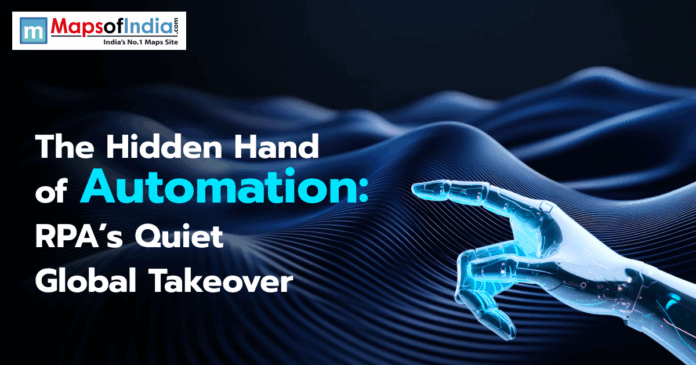The recently developed Robotic Process Automation (RPA) is slowly reshaping many industries. This technology helps automate repetitive tasks with the help of software bots. In today’s time, RPA is no longer a niche. This has become a global force driving efficiency. A recent post by Forbes Council says RPA minimises costs and optimises operations. The automation market has grown from $7.94 billion in 2024 to $9.91 billion in 2025; this much growth has been seen in a year. This reflects a 24.8% CAGR. A recent Grand View Research report says integration with cognitive tech expands its reach. RPA handles data entry and customer service with ease. Its quiet rise transforms work.
RPA’s Origins and Core Mechanics
RPA technology started in the early 2000s. This mechanism emerged from screen scraping and workflow automation. RPA was coined by the company Blue Prism in 2012. This technology mimics human actions on software. Bots interact with apps with the use of UI. This automation technology follows rules for tasks like invoice processing. There is no need for coding for basic bots. Advanced RPA technology uses AI for decision-making. According to the recent report by Statista, 70% of firms use RPA for finance purposes. This helps them to reduce errors by 95%. Mechanics involve recording user actions. Bots replay them at scale. This helps them to save time and cuts many small costs. RPA’s simplicity fuels its adoption. It started in the back offices. Now it spans industries.
Market Growth and Economic Impact
RPA’s market has been exploding in recent times. Forrester predicts it will be valued at more than $22 billion by the end of 2025. Healthcare adoption has grown by 35%. A Grand View Research report says RPA eliminates 40% of service desk interactions by the end of this year. This also cuts operational costs by 30%. According to the article in Flobotics, firms save $40 billion each year. Bots are used to handle 20% of repetitive tasks. This frees humans to do creative work. The economic impact of this is very big. According to the Lumikai report, India’s RPA sector adds Rs. 5000 crore to its economy. Global firms like UiPath are leading in this sector. Their bots process 1 million transactions on a daily basis. RPA boosts GDP by 1.5% in adopting nations. It creates jobs for many people in bot maintenance. Market growth drives innovation.
Integration with AI and Hyperautomation
The technology of RPA is evolving with AI technology. Intelligent automation is used to combine RPA and machine learning. The progress of this technology has optimized customer service. AI bots are learning from the provided data. They can now handle complex tasks like fraud detection. Hyperautomation uses AI for end-to-end processes. This also reduces manual intervention by 80%. RPA with NLP is used to process emails. The use of this has transformed finance and logistics. Bots can now predict inventory needs. This helps to cut waste by 25%. Hyperautomation will be the RPA’s future. A Flobotics report says more than 50% of firms will adopt this technology by 2025. It drives efficiency across sectors. AI makes RPA smarter.
RPA in Key Industries
RPA has been adopted by many diverse sectors. This is being used in many sectors, like in finance, where it automates reconciliation. According to the recent Auxiliobits report, more than 90% of banks are now using RPA. This is helping the industry to save $1 trillion globally. Healthcare also uses RPA for keeping patient records. Adoption of this technology is expected to grow by 35% by 2025. This will help to cut admin time by 40%. Logistics is tracking the shipments with bots. This helps to optimise supply chains. RPA processes 50% faster. Retailers are using this for inventory. A Blue Prism report says it boosts sales by 15%. The government, with the help of this, automates paperwork. A Lumikai report says the use of RPA in India cuts delays by 30%. RPA’s versatility drives its takeover.
Benefits and Quiet Efficiency Gains
The strength of RPA is its subtlety. This runs in the background. According to the recent SS&C Blue Prism use of this technology, it frees 40% of employee time. Bots can also work 24/7 without causing errors. This helps to increase productivity by 20%. A recent Flobotics report says RPA saves $40 billion yearly. It scales easily. Firms are using bots for peak loads. A Blueprint Systems article says the use of this technology minimises costs by 50%. RPA reduces human burnout. It handles mundane tasks. It optimises operations. Quiet gains include better compliance. Bots can log every action. This can also cut audit time by 30%. RPA’s hidden hand drives unseen efficiency.
Challenges and Ethical Concerns
The rise of RPA technology also brings many issues. Job displacement is a fear. According to the recent report of Robotics Tomorrow, more than 20% of tasks are now automated. It creates maintenance jobs, too. We can overcome this by using Ethical AI. Developers also need to develop bots that avoid bias. The risk of data privacy is also growing. Secure bots are essential. Scalability is challenging for small firms. A Flobotics report says 40% firms are struggling with integration. Maintenance costs have also risen by 15%. Training of this bot is needed. Regulatory hurdles vary by country. Compliance is 25% of costs. These challenges temper RPA’s takeover.
Future Prospects and Global Trends
The future of the RPA’s technology is bright. The market of this technology is expected to hit $22 billion in 2025. AI integration grows 40%. Hyperautomation is dominating the industry. It enables end-to-end automation. Sectors like healthcare are adopting this technology 35% more. Bots in recent times have been handling 50% of tasks. Global trends include cloud RPA. It cuts costs by 30%. Developing nations like India are leading its adoption. RPA has added Rs. 10000 crore to the Indian economy. Ethical frameworks are emerging. 60% of firms prioritise bias-free bots. RPA’s quiet takeover continues.
Conclusion
RPA is slowly and quietly revolutionising work. The market of this industry is expected to grow to $22 billion in 2025. From finance to healthcare, it is being used in every sector nowadays, and it boosts efficiency by 30%. It saves $40 billion yearly for this industry. AI integration makes it smarter. It optimises customer service. Challenges like job loss are there. 20% of tasks are nowadays automated. But at the same time, it creates new roles. The use of RPA in every sector is driving global change. It’s the future of automation.





